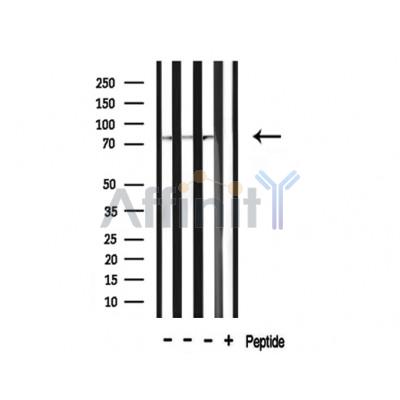ACSA Antibody - #DF3728
| Product: | ACSA Antibody |
| Catalog: | DF3728 |
| Description: | Rabbit polyclonal antibody to ACSA |
| Application: | WB IHC |
| Reactivity: | Human, Mouse, Rat |
| Prediction: | Bovine, Horse, Sheep, Rabbit, Dog, Chicken |
| Mol.Wt.: | 78 KD; 79kD(Calculated). |
| Uniprot: | Q9NR19 |
| RRID: | AB_2836092 |
Related Downloads
Protocols
Product Info
*The optimal dilutions should be determined by the end user. For optimal experimental results, antibody reuse is not recommended.
*Tips:
WB: For western blot detection of denatured protein samples. IHC: For immunohistochemical detection of paraffin sections (IHC-p) or frozen sections (IHC-f) of tissue samples. IF/ICC: For immunofluorescence detection of cell samples. ELISA(peptide): For ELISA detection of antigenic peptide.
Cite Format: Affinity Biosciences Cat# DF3728, RRID:AB_2836092.
Fold/Unfold
ACAS2; AceCS; Acetate CoA ligase; Acetate thiokinase; Acetate--CoA ligase; Acetyl CoA synthetase; Acetyl Coenzyme A synthetase 2 (ADP forming); Acetyl coenzyme A synthetase cytoplasmic; Acetyl-CoA synthetase; Acetyl-coenzyme A synthetase; ACS; ACSA; ACSA_HUMAN; ACSS2; Acyl activating enzyme; Acyl CoA synthetase short chain family member 2; Acyl-activating enzyme; Acyl-CoA synthetase short-chain family member 2; Cytoplasmic acetyl coenzyme A synthetase; cytoplasmic; MYH7B; AceCS1
Immunogens
A synthesized peptide derived from human ACSA, corresponding to a region within N-terminal amino acids.
- Q9NR19 ACSA_HUMAN:
- Protein BLAST With
- NCBI/
- ExPASy/
- Uniprot
MGLPEERVRSGSGSRGQEEAGAGGRARSWSPPPEVSRSAHVPSLQRYRELHRRSVEEPREFWGDIAKEFYWKTPCPGPFLRYNFDVTKGKIFIEWMKGATTNICYNVLDRNVHEKKLGDKVAFYWEGNEPGETTQITYHQLLVQVCQFSNVLRKQGIQKGDRVAIYMPMIPELVVAMLACARIGALHSIVFAGFSSESLCERILDSSCSLLITTDAFYRGEKLVNLKELADEALQKCQEKGFPVRCCIVVKHLGRAELGMGDSTSQSPPIKRSCPDVQISWNQGIDLWWHELMQEAGDECEPEWCDAEDPLFILYTSGSTGKPKGVVHTVGGYMLYVATTFKYVFDFHAEDVFWCTADIGWITGHSYVTYGPLANGATSVLFEGIPTYPDVNRLWSIVDKYKVTKFYTAPTAIRLLMKFGDEPVTKHSRASLQVLGTVGEPINPEAWLWYHRVVGAQRCPIVDTFWQTETGGHMLTPLPGATPMKPGSATFPFFGVAPAILNESGEELEGEAEGYLVFKQPWPGIMRTVYGNHERFETTYFKKFPGYYVTGDGCQRDQDGYYWITGRIDDMLNVSGHLLSTAEVESALVEHEAVAEAAVVGHPHPVKGECLYCFVTLCDGHTFSPKLTEELKKQIREKIGPIATPDYIQNAPGLPKTRSGKIMRRVLRKIAQNDHDLGDMSTVADPSVISHLFSHRCLTIQ
Predictions
Score>80(red) has high confidence and is suggested to be used for WB detection. *The prediction model is mainly based on the alignment of immunogen sequences, the results are for reference only, not as the basis of quality assurance.
High(score>80) Medium(80>score>50) Low(score<50) No confidence
Research Backgrounds
Catalyzes the synthesis of acetyl-CoA from short-chain fatty acids. Acetate is the preferred substrate. Can also utilize propionate with a much lower affinity (By similarity).
Reversibly acetylated at Lys-661 (By similarity). The acetyl-CoA synthase activity is inhibited by acetylation and activated by deacetylation mediated by the deacetylases SIRT1 and SIRT3 (By similarity).
Cytoplasm>Cytosol.
Belongs to the ATP-dependent AMP-binding enzyme family.
Research Fields
· Metabolism > Carbohydrate metabolism > Glycolysis / Gluconeogenesis.
· Metabolism > Carbohydrate metabolism > Pyruvate metabolism.
· Metabolism > Carbohydrate metabolism > Propanoate metabolism.
· Metabolism > Global and overview maps > Metabolic pathways.
· Metabolism > Global and overview maps > Carbon metabolism.
Restrictive clause
Affinity Biosciences tests all products strictly. Citations are provided as a resource for additional applications that have not been validated by Affinity Biosciences. Please choose the appropriate format for each application and consult Materials and Methods sections for additional details about the use of any product in these publications.
For Research Use Only.
Not for use in diagnostic or therapeutic procedures. Not for resale. Not for distribution without written consent. Affinity Biosciences will not be held responsible for patent infringement or other violations that may occur with the use of our products. Affinity Biosciences, Affinity Biosciences Logo and all other trademarks are the property of Affinity Biosciences LTD.



